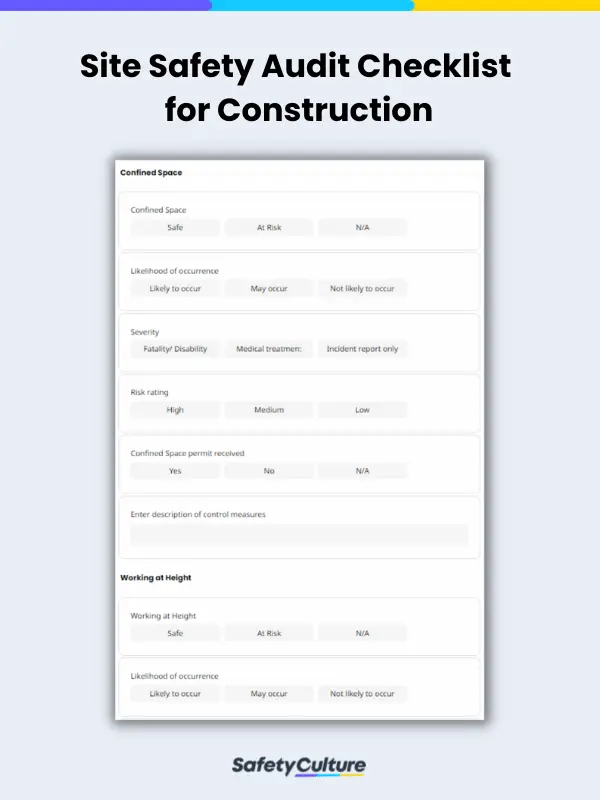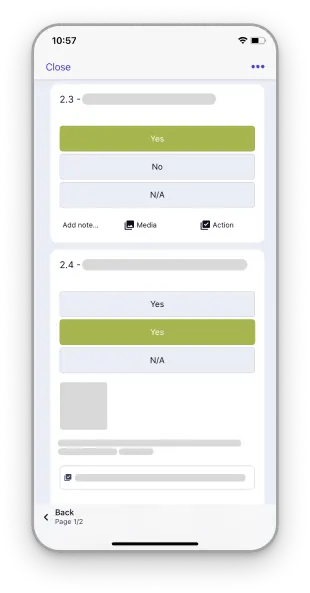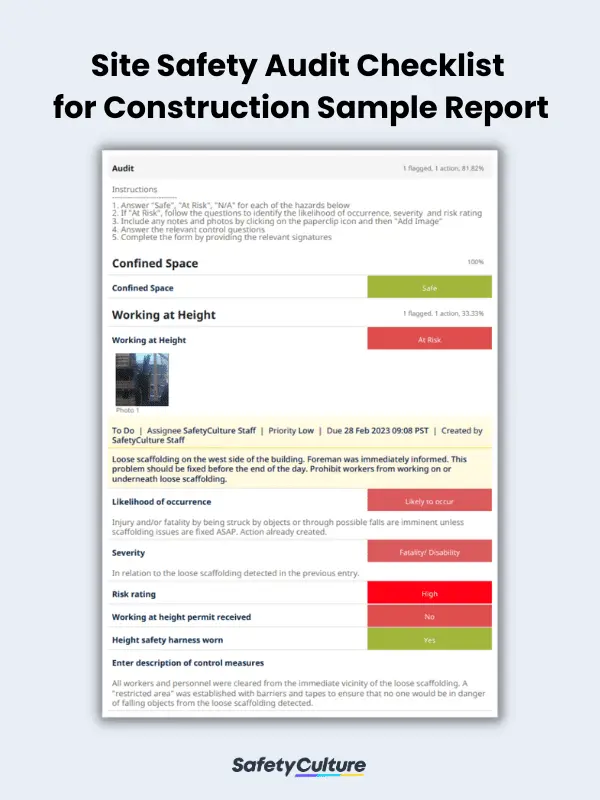What is a Safety Audit?
A safety audit is the process of gathering information to assess the risks and hazards in the workplace. It is performed by internal and external safety officers to evaluate efficiency, reliability, and effectiveness of health and safety systems of the organization. A safety audit checklist is used to ensure organizations comply with safety regulatory requirements to mitigate risks and prevent any work-related incidents, injuries, or fatalities. It is important for an organization to create an audit template that fits the requirements of their industry. The information provided in this form should be specific. This ensures that the documentation process is timely and accurate.
Importance and Benefits
Using safety audit checklists is an essential to maintaining safety in the workplace. Their main importance lies in how they can help identify and address risks and hazards, allowing safety officers, employers, and buisness owners to create and implement the necessary safety procedures to reduce and avoid accidents, injuries, and incidents.
Formatting your safety audit as a checklist in particular makes risk assessments easier to conduct, as it gives you a clear view of things to look out for and observe. It helps ensure that important findings are recorded properly and essential safety procedures are followed as intended. Checklists also keep your documentation systems organized, as well as promote accountability, productivity, and empowerment among your employees to report and address safety issues and concerns.
How to Conduct a Safety Audit
Safety audits are integral to the success of any operation, regardless of the business’s nature. The safety of a work environment influences productivity, worker morale, and overall sustainability. While the exact steps and specifics of each safety audit may vary depending on numerous factors, the following principles apply to effective safety audits regardless of industry:
Ensure that your safety audit checklists and templates fit your use case
Different businesses have different processes, workplace layouts, and safety regulations to comply with. As this can be difficult to do on a large scale, going digital can greatly help your operations and use cases. However, while ready-to-use digital safety audit templates can now be downloaded for free in place of using traditional paper-based ones, it is generally considered good practice to customize your safety audit templates to fit your use case in order to maximize their efficiency and effectiveness.
Check your safety audit procedure for compliance
A compliant safety audit procedure trumps a good safety audit procedure. Before distributing your safety audit procedure template or checklist to the rest of your auditors, ensure that it covers the necessary checks to comply with safety audit standards relevant to your business. For example, a factory safety audit checklist may have different factors in it compared to a construction company’s safety audit checklist or a farm house’s safety audit checklist, so it is important to be aware of the different nuances your industry may have.
There are also legal regulations to be aware of that can differ per state, city, or country. Some of which are the following:
- For businesses based in North America, safety officers need to be aware of applicable OSHA Laws and Regulations so they can customize audit templates to include all of the checks and inspections necessary for compliance.
- For businesses based in the UK, there are regulations in place for safety inspectors and employers for different industries to use health and safety audit forms regularly to ensue their workplaces are safe.
- For businesses based in Canada, regular safety audits are required of all industries, along with safety inspections and risk assessments.
Schedule safety audits and set conditions for ad hoc safety checks
Once you have the right tools to conduct effective safety audits, next comes knowing when and how often you should use them. In general, the thoroughness of your safety audits affect the frequency in which you need to perform them. Some companies prefer a comprehensive annual safety audit, while others may opt for a less comprehensive quarterly safety check.
Ad hoc safety audits should also be performed whenever a new process, equipment, or tool is introduced into the existing system. This ensures that safety practices are modified if necessary; preserving the overall safety in the workplace.
Be specific when documenting your safety audit findings
Good safety audits and inspections help inform teams so they can create effective control measures against risks and hazards. Safety auditors would do well to be as specific as possible when documenting findings during routine and ad hoc safety audits. Using safety inspection software which allows you to take photos and annotate them mid-audit results in a more comprehensive report that streamlines communication between teams.
Keep your safety audit data safe and secure
With the help of modern digital health and safety audit and safety inspection apps, companies can rely less on safety contractors and third-party auditors in favor of doing internal safety compliance checks with their own in-house experts. Internal safety audits also give companies the added benefit of data security via cloud storage; allowing for custom permissions so only authorized personnel can access audit data.
What Should be Included in a Safety Audit Checklist?
A safety audit checklist should be detailed and comprehensive. It should contain all the essential elements of a building or place of business that needs regular checking. Aside from including the identified risks, safety audit checklists ideally indicate the likelihood, severity, and potential impact level of the said risks.
The following are a few examples of the types of questions for your safety audit checklist:
For Fires and Explosions
Safety audit checklists should help inspectors check fire hazards in workplaces, as well as recognize the risks associated with them. Here are a few sample questions you can include:
- Are employees aware of the evacuation procedures in case of fires or explosions?
- Is the fire alarm system functioning properly?
- Are exit doors easily opened from the inside?
- Are extinguishers in place, clear of obstructions, and marked correctly?
- Is there appropriate direction notices for fire exits?
For Electrical Concerns
It’s the business owners’ and safety managers’ responsibility to ensure that the workplace is free from potential electrical issues. To do this, consider asking the following questions with your safety audit checklist:
- Are safety switches installed?
- Are portable power tools in good condition?
- Is there an existing emergency shut-down procedure?
- Are leads not frayed, damaged, or strained and in a good working condition?
- Are plugs, sockets, or switches not broken and in a good working condition?
For General Building Safety
Aside from other typical aspects to check inside the workplace, safety audit checklists should also help in identifying, inspecting, and correcting potential hazards from the building itself. Consider asking these common questions:
- Are floor surfaces even and uncluttered?
- Are stairs clear from clutters and other obstructions?
- Are liquid spills removed promptly?
- Are footpaths in good and safe condition?
- Are railings in good working condition?
Safety Audit Checklist Form Example
Here is an example safety audit checklist for a construction site for your reference:
FAQs about Safety Audits
Safety audits are performed by individuals or teams who are trained to conduct periodic safety audits and should be independent from the organization or department being audited.
Safety inspections are more frequently conducted and usually done by employees of the company who may belong to the same department being inspected for safety. The safety officers who conduct the safety inspections are more familiar with day-to-day operations.
Regular safety audits should be performed to ensure that organizational safety programs are implemented and practiced as required. It enables leaders and safety officers to verify the effectiveness of said programs by identifying whether or not they are able to proactively recognize potential hazards in workplaces. Aside from conformance with industry requirements, safety audits are also important because as a safety management practice, it is seen to have reduced unsafe conditions in occupational places.




